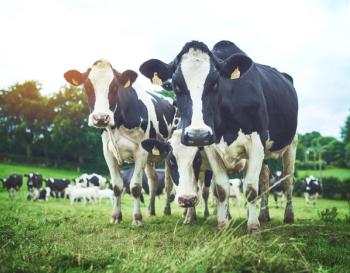
Anti-inflammatories and analgesics for cattle (Proceedings)
Drugs approved in the U.S. specifically for analgesia in cattle do not exist.
Drugs approved in the U.S. specifically for analgesia in cattle do not exist. There are guidance documents from the FDA Center for Veterinary Medicine for companies that would like to have an NSAID approved for pain relief (
Pain
The International Association for the Study of Pain defines pain as an unpleasant sensory and emotional experience associated with actual or potential tissue damage or described in terms of such damage. Others have defined pain in animals as "an aversive sensory experience that elicits protective motor actions, results in learned avoidance and may modify species specific traits of behaviour, including social behaviour" (
Excellent resources exist for veterinarians and producers on how to recognize pain in cattle (e.g.,
Bovine Veterinarians in the U.S. that were surveyed about pain and analgesic use believed that castration of calves <6 months old was the least painful and abdominal surgery in adult cows was the most painful of 17 conditions and procedures (others included dehorning, acute and chronic lameness, and mastitis, in beef and dairy cattle). Veterinarians recognize that pain occurs in cattle. They also treat certain instances of pain. In the same survey, respondents said they treated most animals undergoing abdominal surgeries (drug choices included local anesthetics, so pain relief may be secondary to surgical needs), and an average of 30% of respondents said they used at least one of the listed analgesics for castration of calves <6 months of age.
Mechanisms of Action of Analgesics
Nonsteroidal Antiinflammatories Drugs commonly used in food animals that act by inhibiting enzymes include NSAIDS. NSAIDs work by inhibiting the cyclooxygenase enzymes, including its isoforms COX-1 and COX-2. Arachidonic acid released from plasma membranes is the substrate for these enzymes, and the end-product is a number of prostaglandins and prostacyclins, depending on the substrate available in the cell. The reduction of prostaglandins may result in decreased inflammation and fever. Prostaglandins are also associated with pain, and reduction in prostaglandin production can reduce the central integration of nociception known as pain. Common discussions in the literature now include the appreciation of the differences in affinity of NSAIDs for COX-1 and COX-2 isoforms of the enzyme. COX-1 is generally thought to be expressed constitutively, meaning essentially all the time, and is associated with protective functions, such as regulation of kidney afferent blood flow and mucus production in the gastric and duodenal mucosa. COX-2 is generally thought to be expressed particularly under conditions of inflammation, and therefore, it has been believed that inhibition of COX-2 preferentially would provide a margin of safety. This has been shown to be true in some cases for some drugs, but not always. Allegedly COX-2 selective drugs have been associated with gastric perforation. Part of the issue is how drugs are designated COX-1 vs. COX-2 selective, since the assays to determine the inhibitory ratio for the two isoforms are generally performed in vitro, and the assay used has been shown to alter the ratio significantly. In addition, there are species differences in the specificity for enzyme isoform, so extrapolation from other species is not always accurate.
Alpha-2 agonists
Xylazine and other alpha-2 agonists act by interacting with alpha-2 receptors on post-synaptic membranes, which are associated with inhibition of neurotransmission. Tolazoline and yohimbine reverse alpha-2 activity by receptor antagonism. Alpha-2 agonists have been shown to be analgesic since they inhibit action potentials along pain pathways. These drugs do not provide long-term relief of pain, but are useful for animals undergoing procedures that are likely to be painful for relatively short periods of time.
Opioids
The most commonly used opioid in cattle is butorphanol, a partial agonist/antagonist at mu receptors, receptors involved in pain mediation. Butorphanol administered parenterally provides a few hours of pain relief.
NDMA-receptor antagonist
Ketamine inhibits NDMA receptors, which are responsible for the transmission of nociception from the peripheral to central nervous system. It is analgesic, although it is very short-acting so not practical for long-term pain relief but appropriate for surgical procedures.
Future
As our understanding of the clinical pharmacology of so-far unapproved analgesics improves, we must use that information to develop new and novel means of pain relief, multimodal analgesia, and preemptive strategies to provide for the welfare of the animals in our care. These may include new drugs, new approvals of old drugs (with concomitant dosing and withdrawal time information), or new strategies (epidurals, intrathecal drugs, local analgesia, preventive protocols). Our challenge will continue to be to contribute to the production of safe and wholesome animal products while maintaining high standards of animal care and welfare.
Newsletter
From exam room tips to practice management insights, get trusted veterinary news delivered straight to your inbox—subscribe to dvm360.






